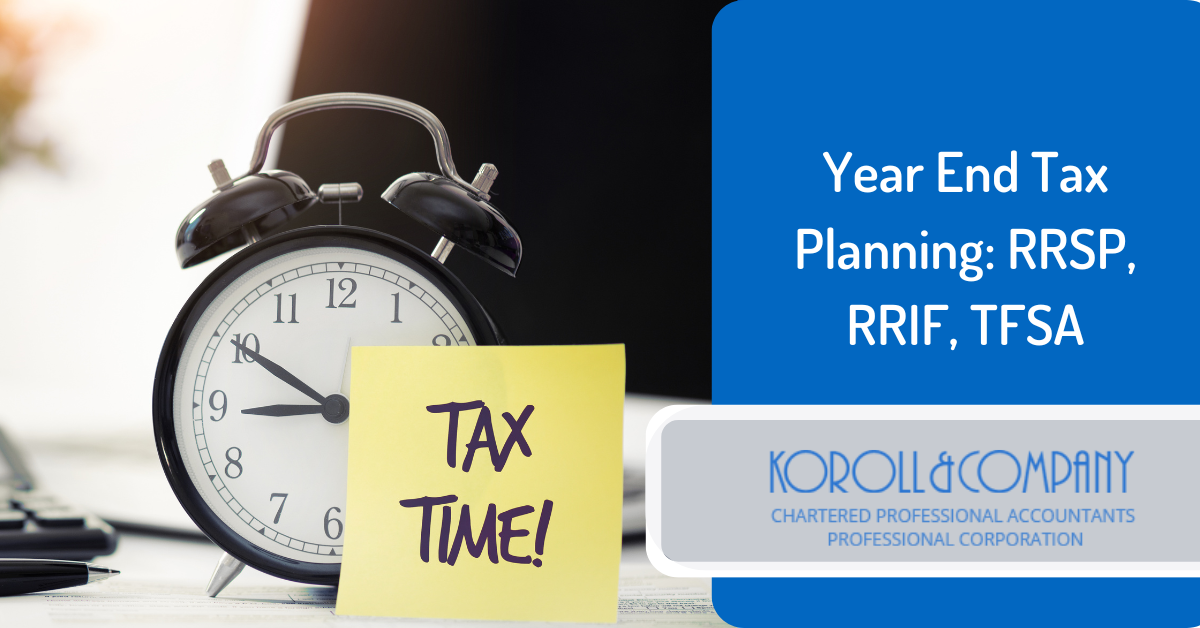 Now that the New Year is almost here, it’s time to start making some year-end tax planning decisions, especially related to an RRSP and TFSA.
Now that the New Year is almost here, it’s time to start making some year-end tax planning decisions, especially related to an RRSP and TFSA.
While most people have until March 1, 2023 to make contributions to their Registered Retirement Savings Plan (RRSP) for the 2022 tax year, there are some taxpayers who should do so before December 31, 2022. Similarly, some people will benefit from withdrawing funds from their Tax Free Savings Account (TFSA) before the end of the year as well.
RRSPs for those turning 71
All Canadians must collapse their RRSP by the end of the year in which they turn 71. This means that contribution will no longer be accepted and that you will have to choose how to collapse the RRSP.
When collapsing your RRSP, you have three options:
- Take it out in cash – Apart from withdrawals made through the Home Buyers Plan and the Lifelong Learning Plan, all income withdrawn from your RRSP is taxable. As a result, if you opt to withdraw your savings as cash in the year you turn 71, all of it will be treated as taxable income, minimizing the total amount you get to take home (in many cases by 50%).
- Purchase an annuity – When you purchase an annuity, you are purchasing guaranteed income for life. Unlike taking a cash withdrawal, the taxes are owed on the payments received on an annual basis and not on the total amount used to purchase the annuity. The amount received from your annuity will depend on several factors which will be discussed when purchasing the annuity such as the guarantee period and whether additional guarantees, such as payment to your spouse after death, are included.
- Rolling money in a RRIF – The final option for collapsing your RRSP is to put your savings into a Registered Retirement Investment Fund (RRIF). By rolling your savings into a RIFF, you can continue to grow your savings while making withdrawals. Unlike an RRSP, however, you are required to receive a minimum amount each year based on the value of the RRIF and your age. Like an annuity, taxes are paid on funds in the year they are received.
If you’re turning 71 before January 1, 2023, this also means that you must make your 2022 RRSP contribution by December 31.
Those contributing to spousal RRSPs
If you plan on withdrawing contributions from a spousal RRSP sooner rather than later, you may want to consider making contributions before the year is over.
Spousal RRSPs can be a great tool for families where one spouse is in a lower tax bracket than the other. In these situations, the higher income earner will contribute to their lower income spouse’s RRSP. The high-income earner can then claim the contribution as a deduction on their own tax return. When the spouse withdraws the funds from their RRSP, the withdrawal will be taxed in the spouse’s hands.
There is, however, one stipulation …
The withdrawal will only be taxed in the hands of the low income spouse if the withdrawal happens no sooner than the end of the second calendar year. So, if you contribute to your spouse’s RRSP in December of 2022, your spouse must wait until January 1, 2025 to withdraw the amount. Otherwise, the withdrawal will be included in your income and taxed accordingly.
As such, if you plan on withdrawing funds from your spouse’s RRSP in the next two years or want the option to do so, putting the contribution in before the end of 2022 means that you will be able to withdraw it one year sooner.
If you wait until January of 2023 to make the same contribution, you would have to wait until January 1, 2026 to withdraw that amount and have it taxed in your spouse’s hands.
For more information on RRSP contributions or to find out your RRSP contribution deadline, contact us today. We look forward to helping you with your tax planning strategy.
Withdrawing funds from TFSA
While there are no limitations on when you make contributions to your TFSA, there are some benefits to withdrawing funds from your TFSA before the end of the year.
You see, when you withdraw funds from your TFSA, the amount will be added back to your contribution room in the following year. That means, if you’re planning to make a withdrawal in the coming months, whether it’s to make an RRSP contribution, renovate your home or go on vacation, withdrawing the funds before December 31 will allow you to re-contribute the withdrawn amounts as soon as 2023, instead of waiting until 2024.
This is an excellent tax planning strategy for taxpayers who want to optimize the income earned on TFSA investments. Especially if you have little TFSA contribution room remaining.
For more information on tax planning with TFSAs, RRIFs and RRSPs before year-end, and after, contact us today. We look forward to discussing how these strategies, and others, can help you optimize your unique situation.






